Written by Mitali Shukla
Normally, actors in a play are used to being onstage when performing theater. What happens when that stage is pulled away from under their feet?
Just two weeks into rehearsals, Chapman’s College of Performing Arts (COPA) halted their production of the play “In the Next Room” March 18 after campus was shut down due to COVID-19. Yet despite the obstacles, the cast and crew were able to put on the show virtually in a live premiere Nov. 20, rehearsing and recording each character over Zoom.
Shayna Sternin, a senior theater performance major, first auditioned for the play in the fall of 2019. It was a unique experience to remotely conduct the show after the original Chapman shutdown, she said.
“It changed the entire concept of the production,” Sternin said. “The director reimagined it for a virtual format and rehearsed over Zoom, so it was definitely very strange, but we made it work.”
“In the Next Room,” written by playwright Sarah Ruhl in 2009, is about the early 1800s history of the vibrator as a cure to female “hysteria,” which used to be considered a medical diagnosis for loss of libidio, anxiety and a variety of other symptoms. The play was nominated for a 2010 Tony Award for Best Play.
“In the Next Room” begins with the story of Dr. Givings, who uses an electrical machine to “cure” women of their ailments. His wife, Catherine, is played by Sternin.
“Hysteria isn’t a real disease. It came from a lack of wanting to understand women – a lack of care or research to know about how women function,” Sternin said.
Catherine is described as a woman who is sexually frustrated in her marriage. During both rehearsals and the performance, Sternin had a green screen behind her while acting in full costume and makeup in the middle of her living room.
“Everything that I’ve learned in class got tested while putting on this production, which was both cool and difficult,” Sternin said. “I live with four other people who are all very understanding, even though I was taking up this big common area for hours and hours every day.”
Catherine shared the screen with the character named Elizabeth, who was played by sophomore screen acting major Madison Meadows.
“Elizabeth is a caregiver as a Black woman and the dilemma of what that looks like, being surrounded by all these rich white people,” Meadows said. “It’s comedic at times, but you’ll see a little bit of her attitude coming out. I had so much fun playing her and exploring her character because she has so many different colors within her.”
Meadows began her acting journey at Booker T. Washington High School for the Performing and Visual Arts in Dallas, Texas. As a freshman at Chapman, she had a meeting with John Benitz, the university’s chair of the Department of Theater.
“He was telling me about this play and I was taken aback by the fact that it was about orgasms and the female anatomy, but I was also intrigued because it sounded really interesting and I wanted to know more,” she said.
One of the biggest problems women and especially women of color face when dealing with the aforementioned concept of hysteria is that Black women are three times more likely to have birth complications, Meadows said.
“The father of gynecology (James Marion Sims) based his practice off of Black women,” she said. “He practiced on them because he believed that Black women couldn’t feel pain. So those same practices are practiced today and it’s ridiculous.”
When asked what audience members should take away from the play, Sternin said that they should prioritize connecting to other people.
“A lot of conflict in the play comes from not really seeing each other and not being able to express their feelings for one another,” she said. “Striving for connection and honesty with one another is what this play is all about. (It’s) even more poignant now when everyone’s feeling a bit disconnected.”

